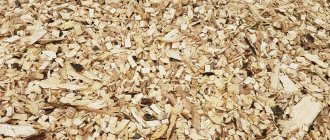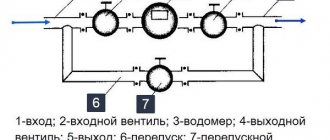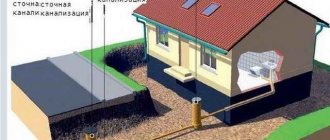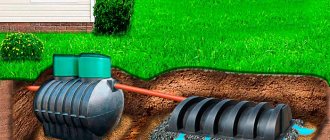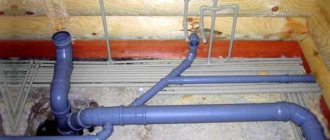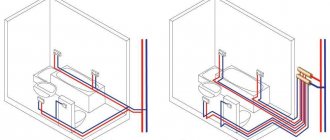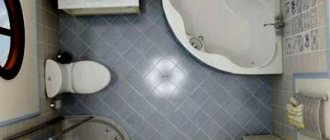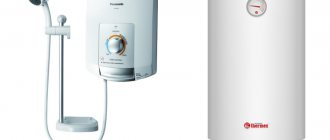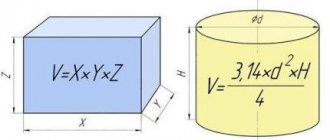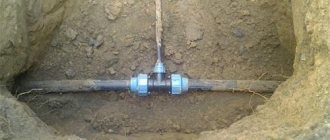Water bodies
Anastasia Zemlyanichko 06/02/2018 no comments
0
( 18 ratings, average: 4.11 out of 5)
- 1 Action plan
- 2 Source of water intake 2.1 Centralized water supply
- 2.2 If the source of water is a well or borehole
- 3.1 How to enter water
- 4.1 Serial connection
Not all private households have running water. Sometimes there is no centralized water supply even down the street. So residents in such settlements use either common wells or wells located in their yard. But we live in a time when running water and sewerage in the home is not a luxury, but a necessity. Thanks to running water in your home, you no longer need to waste time getting water. It can be used for other equally important activities.
Therefore, in this article we will talk about how to supply water to a private house and correctly install water supply through it. Let's look at these questions step by step.
Inputting water into the house: description of possible schemes
There are two types of cold water supply to the house used by specialists:
- using a centralized system;
- decentralized water supply.
In the first case, water is connected using a central water supply. In this case, central backbone networks are used, which are located in close proximity to the connected house.
The decentralized method is used when water supply systems are located far from buildings. In this case, the connection is made through a well or a well, arranged in advance.
When using a centralized water supply connection, all actions to connect to the main line must be coordinated with the water utility. In addition to obtaining permits, you will need to clarify what the connection conditions are, as well as the following information:
- suitable burial depth;
- pressure level in the system;
- optimal supply scheme.
When using a centralized water connection scheme, you will need to install a meter at the final stage. Existing rules allow, if there is a basement in the house, and if it is located closer than five meters from the edge of the site, to install a measuring device in the basement. If the residential premises are located further than the specified standard, you will have to build a well intended for installing the meter.
Types and methods of water supply to a private home
From the perspective of the dependence of the water supply source on external factors, two fundamentally different types of water delivery to the user can be distinguished:
Centralized water supply at home
In essence, the same autonomous, but within the region. In this case, the user does not need to worry about arranging a source of water. All you need to do is connect (cut into) the central water main.
Connecting the house to the central water supply
All actions come down to the step-by-step implementation of a number of requirements, including:
- contacting the regional utility organization MPUVKH KP "Vodokanal" (Municipal Enterprise "Water Supply and Sewerage Management"), which controls the central main;
- obtaining technical characteristics of the insert. The document contains data on the location of connection of the user's pipe system to the main line and its depth. In addition, the diameter of the main pipes is indicated there and, accordingly, instructions for choosing home pipe distribution. The water pressure indicator (guaranteed water pressure) is also indicated here;
- receive an estimate for connection, which is developed by a utility or contractor;
- control the execution of work. Which are also usually performed by UPKH;
- perform system testing.
Advantages of central water supply: convenience, simplicity.
Disadvantages: fluctuations in water pressure, questionable quality of incoming water, dependence on central supplies, high cost of water.
Autonomous water supply at home
You can independently provide water supply to your dacha, private or country house using an autonomous water supply. In essence, this is an integrated approach that includes measures for installing a water supply system, starting with providing a source of water supply, ending with its discharge into the sewer system.
An autonomous water supply system can be presented in the form of two component subsystems:
- water delivery: imported, groundwater, from an open source;
- supply to points of consumption: gravity, using a pump, with the installation of a pumping station.
Therefore, in a generalized form, two water supply schemes can be distinguished: gravity (storage container with water) and automatic water supply.
Using a container (water tank)
The essence of the autonomous water supply scheme for a house is that water is supplied to the tank using a pump or poured manually.
Water flows to the user by gravity. After all the water in the tank has been used, it is filled again to the maximum possible level.
Gravity water supply system - water supply scheme from a storage tank
This method is supported by its simplicity; it is suitable if water is needed from time to time. For example, in a country house that is not visited often or in a utility room.
This water supply arrangement, despite its simplicity and low cost, is too primitive, inconvenient and, moreover, creates a significant weight on the interfloor (attic) floor. As a result, the system has not found widespread use and is more suitable as a temporary option.
Using an automatic water supply system
Scheme of automatic water supply for a private house
This diagram demonstrates the functioning of a fully autonomous water supply system for a private home. Water is supplied to the system and to the user using a system of components.
This is what we will talk about in more detail.
You can implement a completely autonomous water supply for a private home on your own by implementing one of the schemes. There are several device options to choose from:
Water from open sources
These can be surface sources: ponds, rivers, lakes. In some cases, such sources may be water purification systems. But in our country they are not yet widespread.
Important! Water from most open sources is not suitable for consumption. It can only be used for irrigation or other technical needs.
Obtaining water from an open source requires the creation of sanitary protection of water intake sites and is regulated by the provisions of SanPiN 2.1.4.027-9 “Zones of sanitary protection of water supply sources and drinking water pipelines.”
Water from underground sources: swimming pools and aquifers
This water is, in most cases, suitable for consumption.
What problems may arise if you refuse the services of a plumber?
Problems often arise when refusing the services of a professional plumber. Often, cold water is introduced into the house in the immediate vicinity of the sewer at a small height from the surface.
As a result, the water supply pipes end up flooded into the floor. That is, all the bends will be inside the screed. For example, in the case under consideration, the pipe is polyethylene for cold water. Compression fittings are used here too. You can, of course, solder, but you may simply not find such fittings in your region. And you will have to install compression ones, but they cannot be poured into the floor. This is where difficulties arise.
Well or well, pros and cons, what to choose
The opinion that a well always outperforms wells in the quality and volume of water supplied to the house is not without foundation, but in general it is erroneous.
In particular, a properly equipped (namely, closed from debris, but ventilated, promptly disinfected and insulated) well, fed from a powerful aquifer, can produce up to 150-200 liters of fresh and tasty water per day.
The advantages of wells also include comparative energy independence (if the electricity is turned off, water can be collected in the usual way), the possibility of laying and equipping it on your own, and a longer service life (from 25 years and above). With a small number of residents and close proximity to a proven vein, this solution is cheaper for plot owners.
The disadvantages of wells are the risks of drying out in the summer and the need for fairly frequent (ideally, 2 times a year, when the seasons change) disinfection and cleaning. The water obtained with their help may be enough for domestic consumption, but not for watering the garden; in the dry season it sometimes goes down completely. Poor insulation, proximity to drains and stagnation of water at the source greatly reduce its quality.
Artesian and filtration wells do not have the main disadvantage of wells - low and unstable water yield. The aquifers, squeezed at a depth of over 20-40 m, undergo natural filtration by soil, are under constant pressure and are less susceptible to seasonal level fluctuations (when drilling a well in the dry season and reaching a stable horizon, problems with selecting the required volume of water do not arise in the future). The advantages of a well also include protection from external influences and large debris.
The disadvantages of wells are manifested in the high costs of drilling and development, 100% energy dependence, the need for periodic flushing and constant water withdrawal. The work of laying them is extremely difficult to carry out on your own; drilling a well almost always requires special equipment. By analogy with wells, wells cannot be placed near open septic tanks or drainage pits.
The final decision is made based on the parameters of the site and the assigned tasks.
If there is a spring or the upper aquifers are close to the site, it is worth laying a well. The latter can be used both as an alternative source of drinking water and to obtain water for irrigation and technical needs.
If it is necessary to meet the needs of several residents in permanent residences, preference is clearly given to filtration or artesian wells.
What rules should be followed when introducing water into a room?
If you decide to refuse the services of a plumber at the stage of introducing water into your house, follow some rules:
- Make a sewer inlet, and then arrange a water inlet to the side or a little higher. Then you can work with it comfortably.
- At the initial stage, it is imperative to organize isolation. Previously, insulation materials were expensive and unavailable. Now the price for them is normal. For example, the cost of 35 insulation is only 48 rubles. Therefore, purchasing 10-20 meters will not be a problem. But during installation there will be some play in the pipe. That is, it will be inside the insulation, and the play will allow, if necessary, to move it, cut it off carefully, or move it somewhere to the side a little.
Water intake equipment
Unlike the main water supply, with an autonomous connection, the water supply system in a private house includes equipment for supplying water from a source and creating working pressure in the pipelines, as well as storage tanks.
A variety of pump types are used for supply. They can be divided into two main types:
- deep (submersible) - work completely or partially immersed in liquid;
- superficial.
Deep well pumps
Submersible pumps are usually used to extract water from wells, wells and reservoirs. The most common types are:
- Vibrating. Cheap, small in size and weight, but at the same time low in power and service life. In addition, their vibration has a destructive effect on the walls of wells and leads to accelerated siltation of the water intake.
- Centrifugal. Suitable for deep wells, including artesian ones. Capable of supplying water over hundreds of meters, they have high performance and reliability.
- Vortex pumps. A type of centrifugal. Capable of creating high pressures. One of the significant disadvantages is high sensitivity to water pollution.
- Screw pumps. Simple, reliable, insensitive to foreign impurities. One of the significant drawbacks is low performance. Excellent for water intakes from natural reservoirs, for objects with low water consumption.
Water supply schemes with surface pumps and pumping stations
Surface pumps are conventionally divided into supply and transfer pumps. For water intake (supply), in which the distance to the water surface is small or absent, the first type is used (usually centrifugal self-priming units). For example, when operating storage tanks to collect rainwater.
This type of equipment includes pumping stations. They are distinguished by the presence of automation, as well as a built-in hydraulic accumulator - a metal reservoir with a rubber container inside, into which water flows from the pump. Air is pumped between the walls of the tank and the container under pressure. It is this that compresses when water enters and pushes it back when the pump is turned off and water is drawn. The hydraulic accumulator solves two problems:
- Acts as a receiver, maintaining system pressure, reducing the number of pump starts.
- Eliminates the danger of water hammer - sudden surges in pressure when the supply or transfer pump is turned on.
Automation serves to maintain constant pressure necessary for the functioning of engineering systems or plumbing equipment. It works like this:
- When the tap is opened or the irrigation system is turned on, the pressure in the pipes drops. Thanks to the hydraulic accumulator, this process proceeds smoothly.
- At a certain stage, the pressure sensor is activated, turning on the station pump.
- When water use stops, the pump still runs for a while, filling the battery.
- Shutdown occurs after reaching the upper threshold pressure, which is the end of the cycle.
Important! The theoretical depth from which surface pumps are capable of lifting water is 10 meters (the laws of physics no longer allow it). But in practice this value does not exceed 8 m.
Water storage tanks (storage)
An important part of the indoor plumbing system is the water storage tank. Its capacity is usually taken based on the minimum water requirement per day.
The higher the tank is installed, the better. In houses with more than 2 floors it is installed on the upper floors or attics, in one-story houses - in attics. Thus, even when there is a power outage on the ground floor, due to the height of the water column, sufficient pressure is created to wash your hands, wash your face, and activate the flush in the toilet.
The system operates as follows:
- The water intake pump through the street line supplies water directly to the storage tank. The pump is turned on by a float sensor, which is triggered when the water level drops below a predetermined level.
- Water enters the internal pipelines from the tank.
- A small booster pump can be used to create a comfortable pressure.
In such a water supply scheme, it is possible to install several outlets in its different sections. For example, with high purity for drinking and cooking, or with coarser purity for sanitary and household needs.
Methods for insulating pipes
One of the most important stages when introducing water into a private house is insulating the pipes. If this is not done efficiently, freezing of the water supply and related problems may occur.
There are several methods used to insulate pipes:
- laying the pipeline at a level below soil freezing. This option is not always convenient; it is not suitable for all regions of our country;
- installation of a receiver in the pipeline, which creates high pressure inside the pipes. Due to this, their freezing is prevented;
- pipe heating. It is organized by wrapping them around a cable connected to the electrical network. The inconvenience of this method is the increase in electricity charges and possible problems in the absence of it;
- insulation of the pipe using umbrella-shaped insulation. In this case, the heat from the soil will help prevent the pipes from freezing;
- Another interesting way is to place the pipes that need to be insulated into others of larger diameter filled with thermal insulation material.
Water supply to a private house: external water supply
The entire water supply system located outside the house is called external water supply. The plumbing inside the house is called internal. Internal and external water supply systems have their own characteristics and installation methods. Since winter external water supply is all-season, and the technology of its construction is more complex, we will pay special attention to it.
The external water supply of a private house delivers water from the water supply source to the house, or rather, to the point of water supply entry into the house. Sometimes water is delivered from the source to the house using a hose deployed around the area. This method is not even slightly stationary, so we will not consider it.
Any stationary external water supply (summer and winter) is laid in the ground. For summer water supply, a trench is dug up to 50 cm deep. For winter water supply, the depth of the water pipe should be 50 cm below the soil freezing level, and each region has its own freezing depth.
Pipe connection
Regarding the connection of different types of pipes. This is also where problems often arise. For example, there is no factory adapter to switch from an asbestos pipe to a plastic one (now about sewage). In such cases you have to invent.
You can, of course, not install an asbestos pipe; instead, take an orange pipe for exterior use, and calmly bring it into the house. Inside the room, the transition to the desired diameter is already underway.
However, if you still decide to use an asbestos pipe, you can proceed as follows to switch from it to a plastic pipe without using an adapter. Pipe insulation made of foam rubber is wound onto a half-meter piece of plastic pipe, fixed with wire, lubricated generously with silicone and tightly inserted into the asbestos pipe with continuous scrolling. In this case, high-quality tightness is ensured for a long time. This is explained by the fact that all materials are synthetic: rubber, silicone, plastic, asbestos are indestructible for a long time.
Installation of a water supply system
Hidden pipeline installation
External and internal pipe routing differ approximately like open and hidden wiring.
Hidden plumbing involves placing pipes inside walls or trim. External wiring assumes an open arrangement of pipes.
It makes sense to consider semi-hidden wiring, when pipes are hidden in special boxes, like computer network wiring. The boxes can be left unfinished, or they can be painted or covered with the same material as the walls.
Hidden installation of plastic pipes in a cottage
The most difficult moments are to accurately think through an autonomous water supply scheme, individual for each private house, think through the sewerage system and punch holes in the walls for pipes.
When calculating the water supply system, the capacity of the well and the water consumption of each water intake point should be taken into account.
Connections, installation of pipes and equipment in a private home is labor-intensive and painstaking, hard work, but quite feasible for an adult.
Installation tips
- To pass through walls, use special pipe gaskets. This will help protect pipes from damage and abrasion and walls from corrosion.
- Use threaded connections as much as possible.
- When installing drain taps, create a slight slope towards the tap. This will prevent water from accumulating in the system after draining.
- Try to avoid unnecessary bends in the plumbing, as bends reduce the pressure in the pipe.
- Use the same mounts, splitters and fittings throughout the system.
- Be sure to have a small supply of fittings, fasteners, FUM tape, tees, ball valves, gaskets and seals. If you have fulfilled the requirements of the previous paragraph, then spare elements will fit anywhere in the system.
- Be sure to install shut-off valves to be able to quickly shut off part of the system.
Pipe materials: advantages of plastic
When installing modern water supply systems, plastic pipes are most often used. They have a number of advantages over other materials:
- reliability;
- comfort in use and installation;
- ease.
Recently, metal-plastic and metal pipes are practically not used. This is explained by their high price, as well as much less practicality. In addition, such materials require the use of welding equipment during the installation process.
When organizing a water supply system using plastic pipes, no special knowledge is required. To bring sewage and cold water into the house using them, crimping equipment is sufficient. An ordinary team of builders can work with such materials. Plastic pipes can be hidden in the decoration. The only condition is that in places of possible temperature fluctuations it is necessary to create bends that will prevent breakthroughs in the future.
Pipe for internal water supply
There are several options: copper, polypropylene, metal-plastic and steel. Let's look at the main characteristics .
- A copper pipe does not undergo oxidation, therefore it does not rot, withstands high pressure, microbes do not grow in it, and it does not become overgrown with various deposits like a steel pipe. When freezing, it stretches and does not burst, thereby maintaining the integrity of the pipe. The thickness of the pipe walls is only one millimeter, which makes it possible to use a pipe with a smaller outer diameter for the required internal cross-section. The disadvantage is the price of both the pipe itself and the fittings.
- Polypropylene pipe is quite durable, has good characteristics, the pipe material does not corrode, and has good throughput. A reinforced polypropylene pipe has been created for hot water. These pipes can be hidden in the walls during installation.
- Metal-plastic pipes have an aluminum base, they are polypropylene inside and plastic outside. They are also not susceptible to corrosion, but are afraid of ultraviolet radiation. It is better not to use for hot water; they become deformed at high temperatures.
- Steel pipes are quite durable, but installation is quite difficult. Subject to corrosion. They need to be in open areas during operation.
The pipe must be selected depending on your financial capabilities, as well as the technical parameters of the circuits that you use at home. It is especially important to use high-quality materials in critical water distribution areas.
0
( 18 ratings, average: 4.11 out of 5)
Back
Toptun shower: product features, operating principle and reviews
MORE
How to choose the correct size of pipes for water supply?
When introducing water into your home, it is important to choose the correct size of pipes used. If it is too small, several problems may arise:
- water may pass noisily through laid pipes;
- A coating forms inside the pipe, which makes it difficult for water to move through.
When choosing a pipe diameter, experts recommend relying on 2 main indicators: the speed of water movement, as well as the total length of the pipeline. The first parameter is usually standard: water moves at approximately 2 meters per second. The second largely depends on the area of the house and the distance of the plumbing equipment.
So, if the planned length of the pipeline is up to ten meters, it will be enough to use pipes with a diameter of 20mm, 10-30m - 25mm and over 30m - 32mm.
Compliance with all the rules will help you cope with introducing water into the house on your own. However, even if builders will install plumbing into your home, it would be a good idea to consult with plumbers. They will tell you how best to do this and what materials to use for this. It is important to make sewerage and water at a distance of at least half a meter. The pipes bringing water into the house should be made a little higher so that they do not flood into the screed. The sewer can be filled without problems. You may need to connect various devices to the water pipes: a storage tank or a pump. If we take into account all the nuances, then the pipeline, even organized without the involvement of a professional plumber, will last for many years.
Water connection point
The beginning of the water supply scheme for a country house is the water source. Within the city, if there is a developed water supply system in the region where the house or summer cottage is located, the power supply is served by a centralized main.
To make a connection to the highway, you must perform the following steps:
- Get permission from those. conditions for connection from the owner of the main line - the city or district management of water and wastewater supply networks.
- Build a pit (well, caisson) to place valves and water meters. To do this, a hole is dug in which it is mounted from concrete rings, plastic or ceramic bricks. If a suitable structure already exists, use it.
- Make a connection or, as plumbers say, a tie-in. To install it, the main line is blocked, but it is also possible to insert it into an existing line.
- Install a valve that allows, if necessary, to shut off the water supply to the house, and install a water meter.
- At the final stage, a representative of the water supply system seals the water meter, takes readings, and in some cases even takes a photo of the unit.
- Next, a water use agreement is concluded, which indicates the limit of water consumption, as well as the discharge of wastewater (if there is a centralized sewerage system).
At the same time, the well sinuses are filled up, a floor slab and an inspection hatch are installed. Laying a water supply line to the house.
Autonomous sources in the water supply scheme of a private house
In the absence of a central water supply, autonomous sources of water intake are used. The most common are wells and boreholes.
Important! According to legal requirements, the placement of a well or borehole requires permission from local authorities. In addition, if a well is deeper than 5 meters, the law requires that it be put into operation by obtaining a license.
- There are three types of wells:
- artesian, with a depth of over 50 m. Otherwise, they are also called “limestone”, since underground water lenses are usually located in calcareous rocks.
- onto the aquifer or, as they also say, “onto the sand.” Such wells are fed by top water that saturates the sandy layers of the soil;
- a needle well, like a sand well, is designed to draw water from shallow groundwater aquifers. Its main difference lies in the technology of the device. A conventional well is drilled or pierced with a bailer, followed by immersion of the casing pipe. A needle well is performed by driving a special perforated pipe all the way to the aquifer.
Shallow wells have a noticeably lower flow rate (the volume of water they produce over a period of time) than artesian wells. The latter are capable of producing from 3 m3/hour (the volume depends on the performance of the pump and the diameter of the well). The average flow rate of a well using groundwater is 0.5 m3/hour.
- Mine water wells are used in shallow aquifers. Their maximum depths reach a little more than 20 m. However, even wells deeper than 10 meters are rarely built.
- There are also springs in the areas. In fact, these are natural wells created by cracks in the earth mass or outcrops of aquiferous rock to the surface. Using a spring as a permanent source of water supply is possible with sufficient flow and good quality of water from it.
- Open bodies of water: a pond, a lake, a river flowing nearby are another opportunity to get water. This also includes storage tanks for collecting precipitation, popular in arid regions. However, such water intakes rarely provide water suitable for drinking without preliminary purification. But even after this, it is used mainly for technical needs.
Important! The factor of environmental cleanliness should also be given special attention when operating shallow wells or wells. Due to their shallow depth, they are overly susceptible to the influence of sedimentary, as well as nearby sources of pollution in the area. In addition, the productivity of small wells, wells, springs, and open reservoirs is affected by seasonal fluctuations in groundwater levels.
